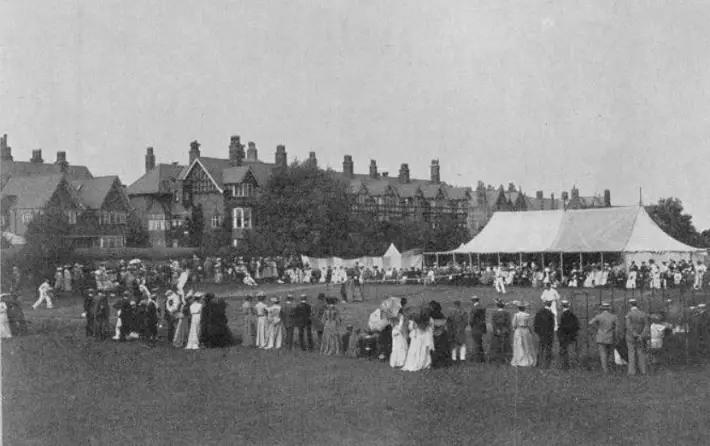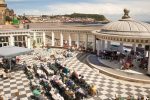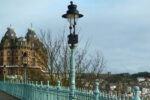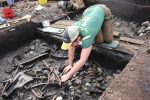The Illustrious History of Tennis in Scarborough
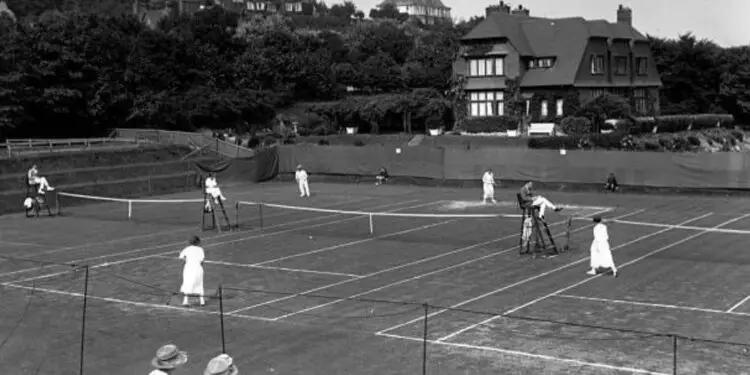
By Kevin Jeffreys
Scarborough was ideally placed to benefit from the late-Victorian discovery and growth of lawn tennis. It was an established seaside resort with good railway connections that helped facilitate an influx of wealthy visitors every summer. The town was for several decades the prime Yorkshire location offering top notch – and, in time, varied forms of – international standard tennis.
From the mid-1880s the tennis club at South Cliff (pictured above) in Scarborough, overlooking the sea, hosted the prestigious North of England Championships. Pre-1914 winners of the tournament included arguably the world’s best of the age: Laurence Doherty, the first real superstar of lawn tennis and four-time winner at South Cliff; and Dorothea Douglass, who in due course won Wimbledon on seven occasions.
“Massive draw”
South Cliff’s exposed coastal setting meant it suffered more than its fair share of disruptive weather (an umpire’s tall chair, with the official in situ, was once blown completely over by the piercing wind), and after 1910 the tournament was shifted to the more sheltered environs of the Yorkshire Lawn Tennis Club, at the base of Oliver’s Mount in Filey Road.
After the First World War, Scarborough blossomed into the beating heart of Yorkshire tennis. The newly-appointed referee for the North of England Championships in 1921 lauded the two show courts in Filey Road – cleverly shielded from the worst excesses of the wind – as among the finest he saw on his travels, and described the standard of play as the best in England that year outside of Wimbledon.
The decade or so after 1945 marked the full (and, as it turned out, final) flowering of top-quality tennis at Filey Road. What elevated this period above others was the fact that Scarborough had various strings to its bow, over and above its hosting of a distinguished summer tournament. The immaculately maintained grass courts were deemed suitable to host five of Britain’s ties in the Davis Cup (the premier international team competition in tennis), a respectable total that placed it on a par with far larger venues such as Manchester.
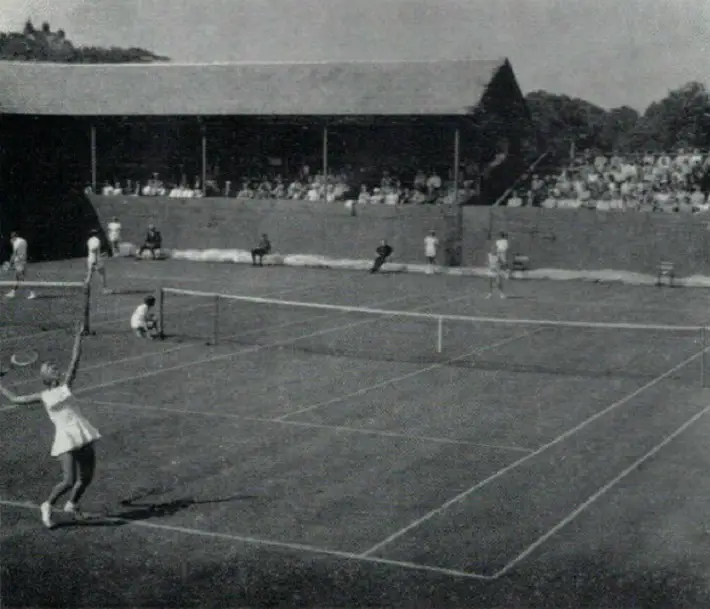
During the televising of the men’s doubles final in 1965, the women’s singles final was played on an adjoining court
“Run its course”
A further massive draw for spectators at Filey Road after the Second World War was a newly-created event for professional players, the Slazenger Pro Championships. This was won three times by Stockport-born legend Fred Perry, including victory in 1948 over Frenchman Yvon Petra, the first post-war men’s champion at Wimbledon. Other winners of the Slazenger Pro included American stars Jack Kramer and Pancho Gonzales.
By the time the Slazenger meeting left town in 1958, the showcase North of England Championships were also past their prime. European players increasingly gave priority to tournaments on the continent once Wimbledon was over, and from the early 1960s on the numbers arriving from elsewhere in the world also fell.
The clearest indication that the post-1945 lease of life enjoyed at Filey Road had run its course came when plans were approved in 1968 to turn the whole site into a multi-sport leisure centre. In the brave new world of ‘Open tennis’, more commercialised than hitherto, the North of England Championships were relocated elsewhere and Scarborough lost its status as the stand out tennis venue in the region.
 “Golden age”
“Golden age”
History, it’s often said, is written by the winners. With this in mind, frontline English tournaments still flourishing on home shores today, at the likes of Queen’s Club in London and at Eastbourne, are warmly praised as ‘winners’, their famous pasts seen as an integral part of their contemporary appeal.
By contrast, Scarborough is often overlooked. It suffers not only because the leading stars of the day who played there have long since departed the scene, but also because the site in Filey Road where the action took place is no longer associated with top-level competition.
And yet, Scarborough richly deserves to be remembered and celebrated for its tennis exploits. Its golden age lasted for almost half a century and featured many of the best-known names in the sport – amateurs and professionals, men and women alike – all striving for success in front of crowded stands on what were once described as two of the most perfect grass courts in the kingdom.
Article adapted from ‘Beyond SW19. World Class Tennis in England since the 1880s’, published by Pitch Publishing, £19.99 hardback
